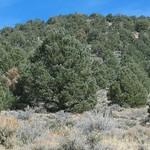The BLM Bishop Field Office offers online Christmas tree cutting permits
Organization:
BLM Office:
Media Contact:
BISHOP, Calif. — The Bureau of Land Management Bishop Field Office is offering personal use Christmas tree cutting permits, now available online, for designated cutting areas on public lands near Benton and Bridgeport in Mono County through Dec. 24.
“We are again offering an online purchase option for Christmas tree permits this year,” said Bishop Field Manager Sherri Lisius. “We are excited to be able to continue this holiday tradition for the community.”
Permits are available for purchase at $5 per tree, with a limit of 5 trees per purchaser. Christmas trees may only be harvested in designated cutting areas on BLM-managed public land, and permit stipulations must be followed. To purchase your permit online, please visit forestproducts.blm.gov to process your permit, find maps of designated cutting areas and read permit stipulations. For questions, please call the Bishop Field Office at (760) 872-5000.
To process your permit online, select the map icon of California and the Benton-Bridgeport cutting area, then follow the prompts to complete your purchase. The site will send you to Pay.gov to process payment for your permit via credit card or bank transfer. The process takes just minutes and the site will email you a copy of your electronic permit.
Those interested in tree cutting in the Lida Summit area of Nevada, or other areas managed by the BLM Tonopah Field Office, can call (775) 482-7800 to have a permit mailed to them. Please allow one week for processing.
The BLM manages about 245 million acres of public land located primarily in 12 western states, including Alaska, on behalf of the American people. The BLM also administers 700 million acres of sub-surface mineral estate throughout the nation. Our mission is to sustain the health, diversity, and productivity of America’s public lands for the use and enjoyment of present and future generations.

